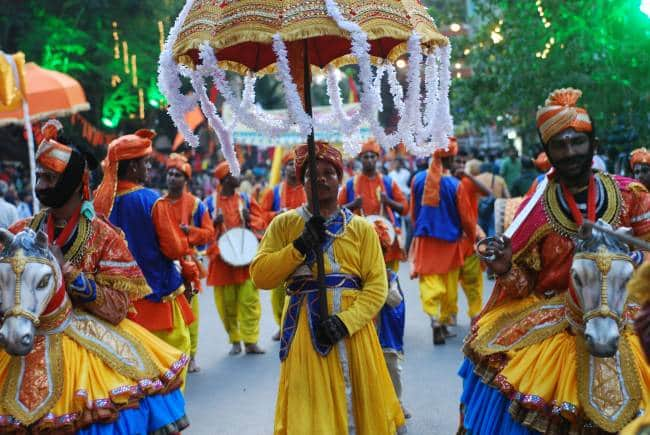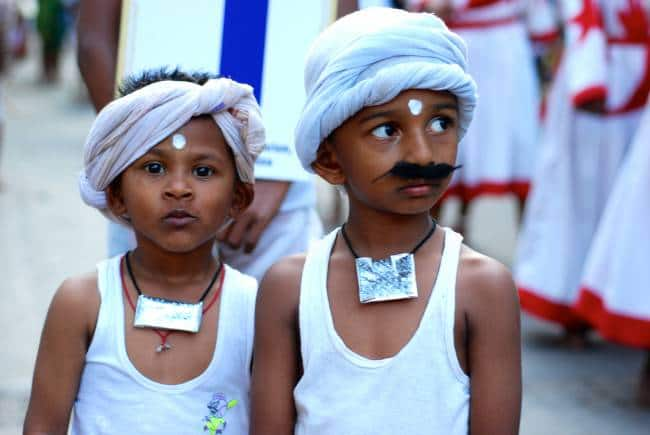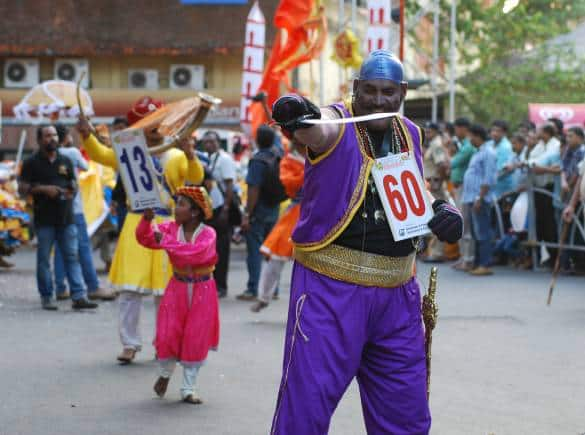



Borrowing from the Prakrit word Suggimaho and Sanskrit Sugrishmaka, and also known as Shishirotsava, Shigmo is a Konkani Hindu festival that celebrates the end of winter and the beginning of Spring.
Held in the month of phalgun (March), Shigmo is a fortnight-long festival that includes Holi and parades showcasing traditional music and dance as well as elaborately built tableaux that depict scenes from Hindu mythology and legends.

There are several stories about the origins of Shigmo. Legend has it that Holika, Pralhad's aunt, instigated her royal brother Hiranyakashapu to inflict every kind of torture on his son Pralhad to dissuade him from repeating the name of the lord. People revolted against Holika, chased her until she threw herself into the pyre.
Others attribute it to the commemoration of the cremation of Putana who was sucked to death by the infant Krishna when she came to poison him. There are still others who celebrate it in memory of the death of cupid Kamadev caused by the wrath of Lord Shiva because the former had the audacity to tempt Shiva while he was in penance.

In earlier days, Shigmo was celebrated in Goan villages to honour the homecoming warriors who left their families to fight the invaders. People performed various traditional folk dances and enacted scenes from mythological stories to welcome the returning warriors.
There are two different ways of celebrating Shigmo: Dhakto Shigmo (small Shigmo) and Vhadio Shigmo (big Shigmo).
Dhakto begins five days before the phalgun full-moon day and ends on the full-moon day in the Old Conquests area of Goa (the areas that were under Portuguese colonial rule for a longer period of time, starting from the 16th century). Vhadio Shigmo, a 5-day celebration begins on the full-moon day in the New Conquests areas of Goa.

Dhakto Shigmo is considered the festival of songs and traditional dances. The 5th day of Dhakto is called Rang Panchami and is celebrated much like the Hindu festival Holi, with ‘gulal’, usually red and blue dry powder.
Shigmo begins with Naman, the invocation of local folk deities on the village maand (village stage) to the beats of percussion instruments like the ghumat, dhol, mhadle and tashe played by men.
Various kinds of dances that are performed during Shigmo, include Hanpet (traditional warrior dance), Divlyanchi Nach (this lamp dance is performed by women who balance heavy brass lamps on their head), Goff (women dance with pieces of cloth in such a way that the pieces intertwine and resemble a rope), Talgadi (dance performed to the beats of instruments like Zanj, Shamel and Ghumat), GhodeModni (‘Ghode' means 'horse' and 'Modni' means 'gyrations and dance-like movements’) and Fugdi (only women participate in this dance), to name few.

Dhol and Tashe are the drums carried as accompaniments to the songs and dances performed. During the entire duration of Shigmo, villagers abstain from alcohol and non-vegetarian food.
The festival concludes with a collective sacred bath called Mad Davarap. It is believed that on the last day of the festival a spirit called the Gade Padap takes over the dancers.

Shigmo Float Parade Dates
March 19: Ponda
March 20: Margao
March 22: Vasco
March 26: Panaji
March 27: Mapusa
The Shigmo Parade will commence at 4 pm and conclude at 10 pm following strict Covid Protocol.
Check traffic advisory for the Shigmo cities. Main streets are usually closed for the parade & vehicular traffic is restricted/prohibited.
 Photos by Preeti Verma Lal
Photos by Preeti Verma Lal
Discover the latest Business News, Sensex, and Nifty updates. Obtain Personal Finance insights, tax queries, and expert opinions on Moneycontrol or download the Moneycontrol App to stay updated!
Find the best of Al News in one place, specially curated for you every weekend.
Stay on top of the latest tech trends and biggest startup news.